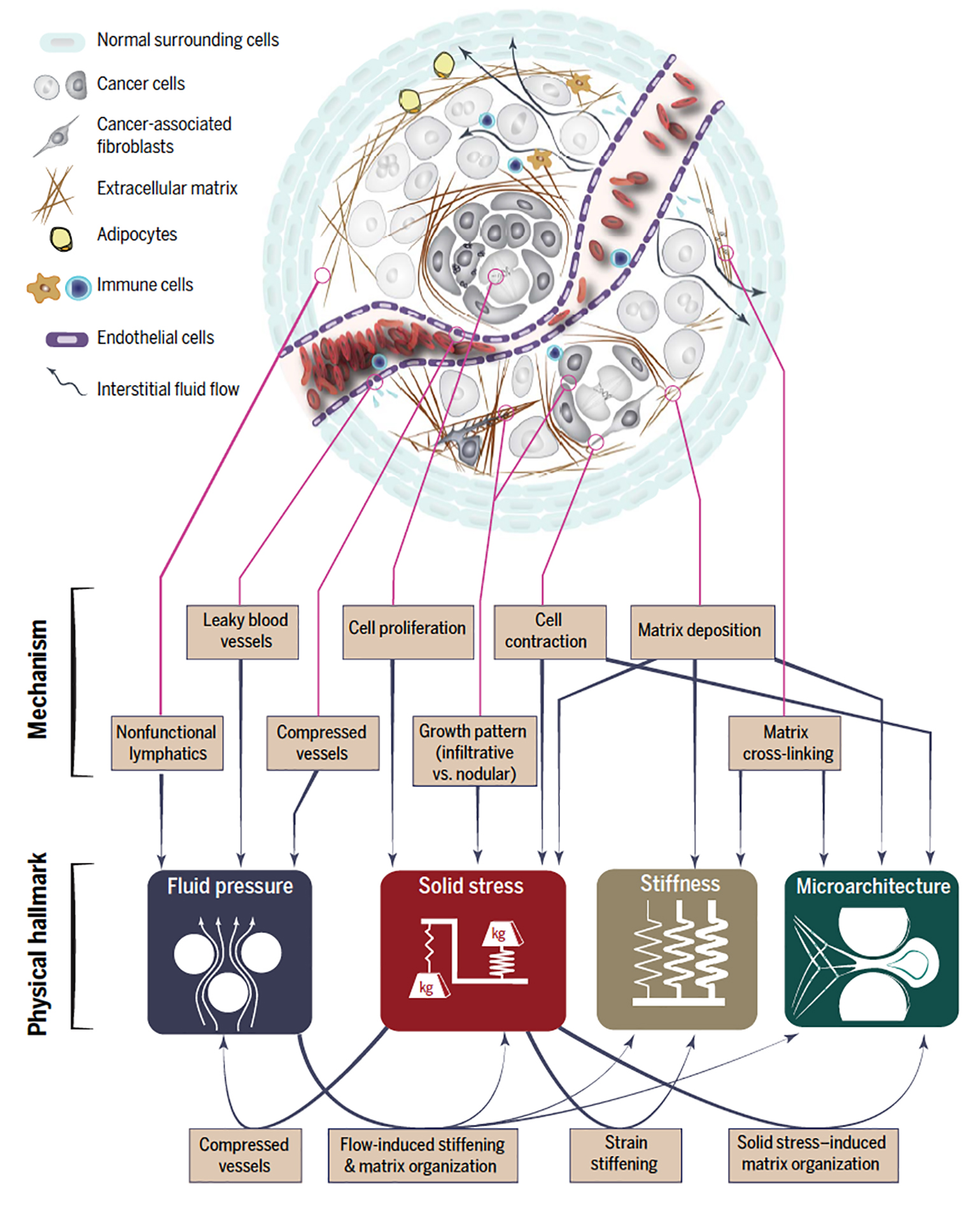Review: Physical Traits of Cancer
Key findings
- An emerging subfield of cancer research is the physical sciences of cancer, in which biologists, engineers, physicists and oncologists study how physical parameters and processes affect cancer progression and treatment
- Massachusetts General Hospital researchers have proposed four key physical traits of cancer: elevated solid stresses, elevated interstitial fluid pressure, increased stiffness and altered tissue architecture
- Growing understanding of the role of the physical microenvironment in cancer has led to several discoveries of new treatment strategies for solid tumors and is expected to do the same in hematologic cancers
As tumors grow, they biochemically and physically disrupt surrounding tissue and recruit normal cells from it. These changes produce physical abnormalities in cancer cells and the microenvironment that can influence treatment response.
Subscribe to the latest updates from Oncology Advances in Motion
In Science, Hadi T. Nia, PhD, from Boston University; and Lance L. Munn, PhD, deputy director of the Steele Labs at Massachusetts General Hospital, and Rakesh K. Jain, PhD, director of the Steele Labs—both researchers in the Department of Radiation Oncology at the Mass General Cancer Center, recently proposed four physical hallmarks of cancer that contribute to tumor progression and treatment resistance.
Elevated Solid Stresses
Mechanical forces are contained in—and transmitted by—the extracellular matrix and cells. These solid stresses can be large enough to compress and even collapse blood and lymphatic vessels, contributing to hypoxia and interfering with chemotherapy, radiation and immunotherapy. Solid stresses may also directly affect tumor biology, such as by promoting cancer cell invasiveness.
Elevated Interstitial Fluid Pressure (IFP)
In most normal organs, excess fluid is drained by lymphatic vessels and IFP is nearly zero. This balance is disturbed by tumor abnormalities, including hyperpermeable blood vessels and compression of blood and lymphatic vessels by solid stress.
High IFP hinders drug delivery from the vasculature into the tumor. It also drives interstitial fluid from the tumor toward surrounding tissue, which can promote tumor invasion and growth, facilitate angiogenesis and remove therapeutic agents from the tumor.
Stiffness
Tumor stiffness has been used for years as a diagnostic marker and more recently as a prognostic marker because stiffness promotes tumor progression. Among other consequences, increased stiffness can induce invasion and metastasis, enhance immune cell infiltration and increase angiogenesis and vessel permeability.
Altered Tissue Architecture
When normal tissue architecture is disrupted by cancer growth and invasion, stromal and cancer cells and the extracellular matrix are reorganized. This changes interactions between individual cells and surrounding tissue, affecting signaling pathways associated with invasion and metastasis.
Growing understanding of the role of the physical microenvironment in cancer has led to several discoveries of new treatment strategies for solid tumors and is expected to do the same in hematologic cancers.

Physical interactions of cancer cells with stroma give rise to physical traits of tumors through distinct and interconnected mechanisms. Leaky and compressed blood vessels and nonfunctional lymphatics lead to increased interstitial fluid pressure within the tumor and interstitial fluid flow in the tumor margin. Cellular proliferation, matrix deposition, cell contraction and abnormal growth patterns lead to compressive and tensile solid stresses. Matrix deposition and crosslinking cause increased stiffness in tumors. Cell contraction, matrix deposition, and cross-linking also alter the architecture of the tissue. The physical traits also interact with each other; solid stresses compress blood and lymphatic vessels and contribute to increased fluid pressure in tumors. Tensile solid stresses result in stretched and aligned matrix, and through strain-stiffening, solid stresses also increase tumor stiffness. Fluid flow activates fibroblasts, which then contribute to increased solid stresses and stiffness values and alter ECM architecture.
view original journal article Subscription may be required
Learn more about the Department of Radiation Oncology
Refer a patient to the Mass General Cancer Center